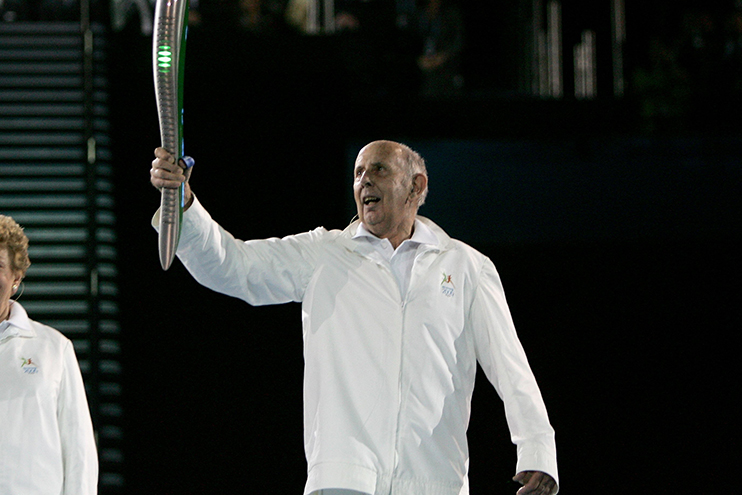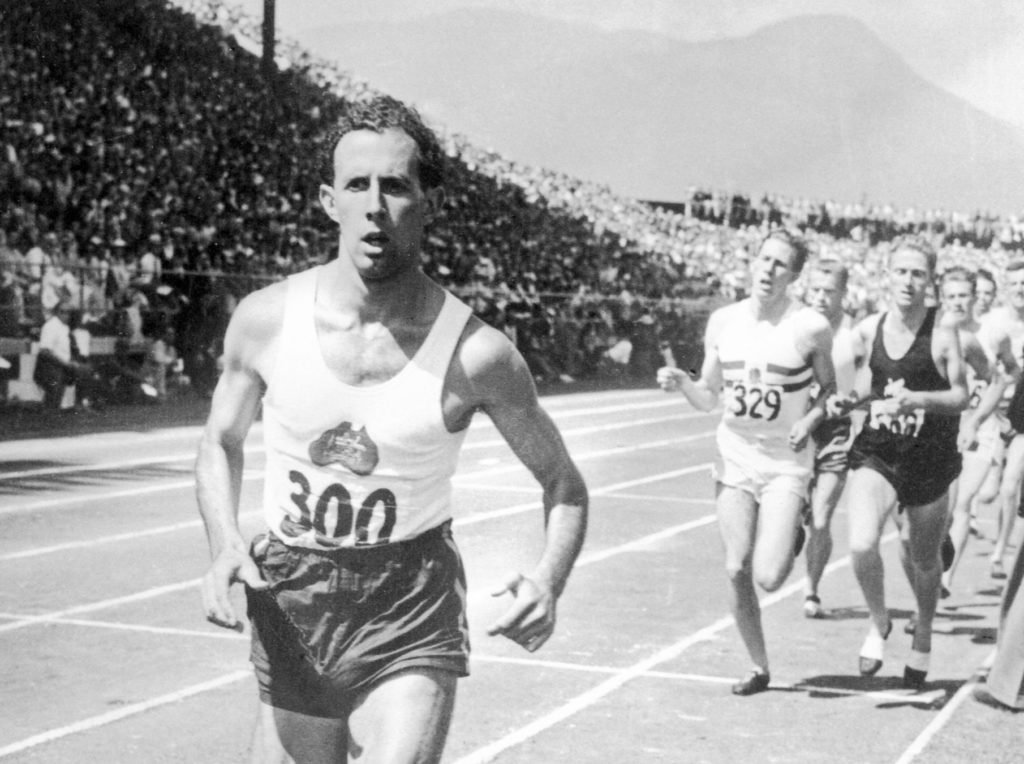John Landy AC CVO MBE, one of Australia’s great sportsmen, has died at the age of 91 after a life full of achievement both on and off the athletics track.
The middle distance legend, who was the second man to break the four-minute mile barrier, passed away at his home in Castlemaine, Victoria, on Thursday surrounded by his family after a long battle with Parkinson’s.
Landy, a figure of huge integrity and class, was responsible for the finest and most selfless Australian sporting moment of the 20th century – even if it didn’t sit easily with him.
By his own admission, he would have preferred to be remembered as simply a good runner.
Or for becoming the 26th Governor of Victoria, an office he discharged with the same dignity and good sense that characterized his life, or for his work on the Australian Sports Commission, or his writings on nature.
Or perhaps even for creating one of his country’s finest butterfly collections.
John Michael Landy may have been one of the greatest middle-distance runners of his era but he was much more – a capable scientist, an author, a humanitarian, a husband and a father.
But it was for his athletic prowess, a talent developed as a boy chasing butterflies through paddocks around Melbourne, that Landy first came to prominence.
He initially took up competitive running to help him get fit for football, only becoming serious about it after making the Victorian athletics team in 1951.
Within 12 months he was on the Australian team for the Helsinki Olympic Games, and a couple of years later became deeply engaged in a battle with Englishman Roger Bannister to become the first man to achieve a feat thought to be beyond human capability – to run a mile in under four minutes.
As Landy and Bannister rolled on toward the magical mark, their ambition became one of the most eagerly anticipated events in the history of track and field.
In the end it was Bannister who won that “race” stopping the clock in a state of near collapse at 3 minutes 59.4 seconds at Oxford on May 6, 1954.
With Landy planning a sojourn to Finland to get better racing and Santee also close to the target, Bannister and his team decided it was now, or maybe never, for British glory. On 6 May 1954, at Oxford’s Iffley Road track, Bannister trailed Brasher for two laps, then Chataway for another lap before a final sprint took him to a 3:59.4 finish and history’s first sub-four minute mile.
Just over six weeks later, Landy ran 3:57.9, beating Chataway by over 40 metres and taking the world record off Bannister. His 3:41.8 at 1500 metres was a world record as well – an extra world mark by way of compensation for not being the first to break four.
Less than two months later in Finland, Landy, who had threatened the mark several times that year, breezed past Bannister’s world record, running 3:57.90.
The stage was set for an epic meeting at the Empire and Commonwealth Games in Vancouver between Bannister, the man with the feared finish, and Landy who had led practically every significant race he ever ran.
Again, Landy’s sense of duty intruded. He felt the world was owed a memorable race, not a cat-and-mouse affair. On the eve of the race, he sustained a deep cut on his foot after treading on a photographer’s discarded flash globe. The cut required four stitches. The doctor was sworn to secrecy.
Those two, sub-four-minute runs preceded the Vancouver 1954 British Empire and Commonwealth Games where Landy and Bannister, the world’s two fastest milers, met face-to-face in a showdown billed as the Race of the Century.
The Englishman won, outrunning and outfoxing Landy who, at a vital stage, looked for him over his left shoulder as Bannister made his move on the right.
Bannister retired from running in 1955 to concentrate on what became a celebrated career as a neurologist, later writing about Landy in Sports Illustrated, describing the Australian as “an athlete faster, neater and more generous than any other.”
Landy, meanwhile, pushed on to the Melbourne 1956 Olympic Games where he was the favourite to win the “metric mile”, the 1500m.
It was in the lead-up to those Games that Landy earned his almost mythical place in Australian sporting folklore.
Running in the Australian Mile Championship in 1956 Landy was in a winning position when fellow athlete Ron Clarke tripped and fell in front of him with about a lap and a half to go.
Landy leapt over Clarke and then turned back to help his rival to his feet, a gesture that cost him valuable seconds and around 50 metres.
After checking on Clarke, he got going again, circled the field and won a race that assured him a place in the Australian Olympic team.
In time, Landy came to view it less gloriously than most, describing it as “that silly race when I whizzed back to Ron Clarke”.
“I reacted on the spur of the moment. I ran down his arm with my spikes when I was jumping over him. That’s why I went back.
“A lot of people seemed to think it was the most significant thing I ever did in running.
“It wasn’t.”
Nevertheless, a statue depicting the incident was erected 50 years later outside Melbourne’s Olympic Park and, in 1999, the Sport Australia Hall of Fame declared Landy responsible for the nation’s Finest Sporting Moment of the Century.
Landy duly ran at the Melbourne 1956 Games, finishing third behind the Irishman Ron Delany.
The Englishman won, outrunning and outfoxing Landy who, at a vital stage, looked for him over his left shoulder as Bannister made his move on the right.
Bannister retired from running in 1955 to concentrate on what became a celebrated career as a neurologist, later writing about Landy in Sports Illustrated, describing the Australian as “an athlete faster, neater and more generous than any other.”
Landy, meanwhile, pushed on to the Melbourne 1956 Olympic Games where he was the favourite to win the “metric mile”, the 1500m.
It was in the lead-up to those Games that Landy earned his almost mythical place in Australian sporting folklore.
Running in the Australian Mile Championship in 1956 Landy was in a winning position when fellow athlete Ron Clarke tripped and fell in front of him with about a lap and a half to go.
Landy leapt over Clarke and then turned back to help his rival to his feet, a gesture that cost him valuable seconds and around 50 metres.
After checking on Clarke, he got going again, circled the field and won a race that assured him a place in the Australian Olympic team.
In time, Landy came to view it less gloriously than most, describing it as “that silly race when I whizzed back to Ron Clarke”.
“I reacted on the spur of the moment. I ran down his arm with my spikes when I was jumping over him. That’s why I went back.
“A lot of people seemed to think it was the most significant thing I ever did in running.
“It wasn’t.”
Nevertheless, a statue depicting the incident was erected 50 years later outside Melbourne’s Olympic Park and, in 1999, the Sport Australia Hall of Fame declared Landy responsible for the nation’s Finest Sporting Moment of the Century.
Landy duly ran at the Melbourne 1956 Games, finishing third behind the Irishman Ron Delany.
It was to be the last shot Landy would have at a major international title.
Landy went on to work in the field of agricultural science, a subject he studied at Melbourne University, and held various positions in sporting and community organisations.
In 2001 he became the Queen’s man in Victoria, serving for five years with typical generosity and openness.
The same qualities, perhaps, led Landy to donate his butterflies, some 10,000 of them, personally collected and catalogued, and estimated to be worth at least $1 million, to the Australian National Museum in 2017.

John Landy was one of the final Queen’s Batonbearers at the Opening Ceremony of the Melbourne 2006 Commonwealth Games (Getty Images).
Tributes have poured in for John Landy, the athletics icon and trailblazer who gave Australia one of its finest sporting moments.
Commonwealth Games Australia CEO Craig Phillips AM says that John Landy was one of the most remarkable people in Australian Sport.
“John’s legacy as an athlete combined with his incredible traits as a person left an indelible mark on all who met him,” Phillips said.
“His epic battle with Roger Bannister at the Empire Games in Vancouver in 1954 is part of world sporting folklore. His involvement in the Commonwealth Sport Movement came full circle as Victorian Governor in the lead-up to the Melbourne 2006 Commonwealth Games, and his role as the final Queen’s Batonbearer at the Opening Ceremony at the MCG.
“And his passing provides an opportunity for us all to reflect on his achievements in sport and life.
“On behalf of Commonwealth Games Australia, we extended our sincere condolences to John’s family, friends and teammates.”
Athletics Australia President Jan Swinhoe said Landy’s contribution to Australian athletics was immeasurable and his loss will be deeply mourned by both the athletics community and the wider Australian community.
“We are incredibly saddened to learn of John’s passing and our sincere condolences are with Lynne, Alison and Matt, as well as the many people within the athletics community who were touched by John’s talent and humility,” Swinhoe said.
“John knew what it took to excel at the highest level, and his determination to reach new heights has inspired generations of Australian distance runners.
“His athleticism was only matched by his sportsmanship and his service to others, and those qualities have allowed him to leave behind a powerful legacy.”
AOC president John Coates said Landy had personified the values of the Olympic movement in every respect and paved the way for a rich era in Australian middle-distance running.
“If Australia needed a role model, it is John Landy. He was a pioneer – and his rivalry with Roger Bannister, as the pair closed on the sub four-minute mark for the mile, captured not only Australia’s imagination, but that of the world.”
Coates said such was Landy’s standing he was selected to read the Athlete’s Oath at the Opening Ceremony of the Melbourne 1956 Olympic Games.
“There could not have been a more appropriate figure to recite the Oath. As a Victorian, at the MCG, at the first Olympic Games to be held in the southern hemisphere, it was quite a moment.”
Landy is survived by his wife Lynne and children Matthew and Alison.
Commonwealth Games Australia extends its condolences to John Landy’s family and friends.
By: Mike Hedge

